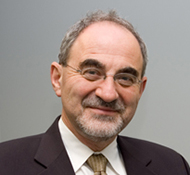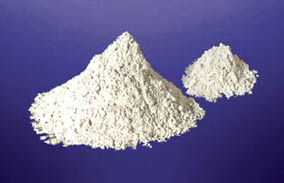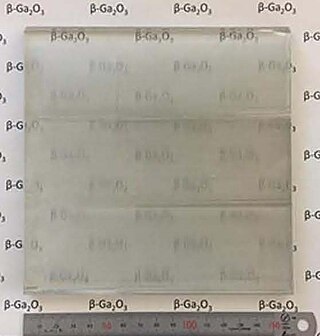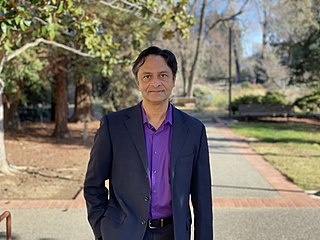Related Research Articles

Nick Holonyak Jr. was an American engineer and educator. He is noted particularly for his 1962 invention and first demonstration of a semiconductor laser diode that emitted visible light. This device was the forerunner of the first generation of commercial light-emitting diodes (LEDs). He was then working at a General Electric Company research laboratory near Syracuse,New York. He left General Electric in 1963 and returned to his alma mater,the University of Illinois at Urbana-Champaign,where he later became John Bardeen Endowed Chair in Electrical and Computer Engineering and Physics.
Wide-bandgap semiconductors are semiconductor materials which have a larger band gap than conventional semiconductors. Conventional semiconductors like silicon have a bandgap in the range of 0.6 – 1.5 electronvolt (eV),whereas wide-bandgap materials have bandgaps in the range above 2 eV. Generally,wide-bandgap semiconductors have electronic properties which fall in between those of conventional semiconductors and insulators.

Eli Yablonovitch is an American physicist and engineer who,along with Sajeev John,founded the field of photonic crystals in 1987. He and his team were the first to create a 3-dimensional structure that exhibited a full photonic bandgap,which has been named Yablonovite. In addition to pioneering photonic crystals,he was the first to recognize that a strained quantum-well laser has a significantly reduced threshold current compared to its unstrained counterpart. This is now employed in the majority of semiconductor lasers fabricated throughout the world. His seminal paper reporting inhibited spontaneous emission in photonic crystals is among the most highly cited papers in physics and engineering.

Aluminium nitride (AlN) is a solid nitride of aluminium. It has a high thermal conductivity of up to 321 W/(m·K) and is an electrical insulator. Its wurtzite phase (w-AlN) has a band gap of ~6 eV at room temperature and has a potential application in optoelectronics operating at deep ultraviolet frequencies.
Indium gallium arsenide (InGaAs) is a ternary alloy of indium arsenide (InAs) and gallium arsenide (GaAs). Indium and gallium are elements of the periodic table while arsenic is a element. Alloys made of these chemical groups are referred to as "III-V" compounds. InGaAs has properties intermediate between those of GaAs and InAs. InGaAs is a room-temperature semiconductor with applications in electronics and photonics.
Thermophotovoltaic (TPV) energy conversion is a direct conversion process from heat to electricity via photons. A basic thermophotovoltaic system consists of a hot object emitting thermal radiation and a photovoltaic cell similar to a solar cell but tuned to the spectrum being admitted from the hot object.

Gallium(III) oxide is an inorganic compound and ultra-wide bandgap semiconductor with the formula Ga2O3. It is actively studied for applications in power electronics,phosphors,and gas sensing. The compound has several polymorphs,of which the monoclinic β-phase is the most stable. The β-phase’s bandgap of 4.7–4.9 eV and large-area,native substrates make it a promising competitor to GaN and SiC-based power electronics applications and solar-blind UV photodetectors. Ga2O3 exhibits reduced thermal conductivity and electron mobility by an order of magnitude compared to GaN and SiC,but is predicted to be significantly more cost-effective due to being the only wide-bandgap material capable of being grown from melt. β-Ga2O3 is thought to be radiation hard which makes it promising for military and space applications.

Isamu Akasaki was a Japanese engineer and physicist,specializing in the field of semiconductor technology and Nobel Prize laureate,best known for inventing the bright gallium nitride (GaN) p-n junction blue LED in 1989 and subsequently the high-brightness GaN blue LED as well.
Ann Catrina Coleman FIEEE FOSA is a Scottish electrical engineer and professor at the University of Texas at Dallas specialising in semiconductor lasers.
Gertrude Fanny Neumark,also known as Gertrude Neumark Rothschild,was an American physicist,most noted for her work in material science and physics of semiconductors with emphasis on optical and electrical properties of wide bandgap semiconductors and their light emitting devices.
Umesh K. Mishra is a professor in the Electrical &Computer Engineering Department at the University of California,Santa Barbara (1990–Present). In 2023,he was appointed dean of the UC Santa Barbara College of Engineering. He is the CTO,co-founder and board member of Transphorm,founded in 2007 and the first company to deliver gallium nitride (GaN) transistor products for high efficiency power conversion technologies. Prior to Transphorm,he co-founded Nitres Inc. in 1996,which was the first company to develop GaN LEDs and transistors.
Manijeh Razeghi is an Iranian-American scientist in the fields of semiconductors and optoelectronic devices. She is a pioneer in modern epitaxial techniques for semiconductors such as low pressure metalorganic chemical vapor deposition (MOCVD),vapor phase epitaxy (VPE),molecular beam epitaxy (MBE),GasMBE,and MOMBE. These techniques have enabled the development of semiconductor devices and quantum structures with higher composition consistency and reliability,leading to major advancement in InP and GaAs based quantum photonics and electronic devices,which were at the core of the late 20th century optical fiber telecommunications and early information technology.
James J. Coleman is an electrical engineer who worked at Bell Labs,Rockwell International,and the University of Illinois,Urbana. He is best known for his work on semiconductor lasers,materials and devices including strained-layer indium gallium arsenide lasers and selective area epitaxy. Coleman is a Fellow of the IEEE and a member of the US National Academy of Engineering.
Jingyu Lin is a Chinese-American physicist and engineer working in the field of wide bandgap semiconductors and photonic devices. She is a co-inventor of MicroLED. In 2000,the husband-wife research team led by Hongxing Jiang and Jingyu Lin proposed and realized the operation of the first MicroLED and passive driving MicroLEDmicrodisplay. In 2009,their team and colleagues at III-N Technology,Inc. and Texas Tech University realized and patented the first active driving MicroLED microdisplay in VGA format by heterogeneously integrating MicroLED array with Si CMOS active-matrix driver. MicroLED display market is expected to hit US$24,307.4 Million by 2027.

Lisa Marie Spellman Porter is an American materials scientist who is a Professor of Materials Science at Carnegie Mellon University. She works on new ways to process and characterise electronic materials. She has previously served as president of the American Vacuum Society.
Theda M. Daniels-Race is an American engineer and Michael B. Voorhies Distinguished Professor in the Division of Electrical and Computer Engineering at Louisiana State University. Her research is in nanoelectronics,specialising in the growth and characterization of nanomaterials and hybrid electronic devices based on compound semiconductors.

M. Saif Islam is a Bangladeshi-American engineering professor of Electrical and Computer Engineering at the University of California,Davis.
Xiuling Li is an distinguished electrical and computer engineering professor in the field of nanostructured semiconductor devices. She is currently the Temple Foundation Endowed Professorship No. 3 in Electrical and Computer Engineering and Fellow of the Dow Professor in Chemistry at the University of Texas at Austin. Previously,she was a Donald Biggar Willet Professor in Electrical and Computer Engineering and Interim Director of the Nick Holonyak Jr. Micro and Nanotechnology Laboratory at the University of Illinois at Urbana-Champaign.

Srabanti Chowdhury is an Indian-American Electrical Engineer who is an associate professor of electrical engineering at Stanford University. She is a senior fellow of the Precourt Institute for Energy. At Stanford she works on ultra-wide and wide-bandgap semiconductors and device engineering for energy-efficient electronic devices. She serves as Director for Science Collaborations at the United States Department of Energy Energy Frontier Research Center ULTRA.
Joan M. Redwing is an American materials scientist known for research on electronic and optoelectronic materials,including the processing of semiconductor thin films and nanomaterials by metalorganic chemical vapor deposition (MOCVD). Redwing is a distinguished professor of materials science and engineering and electrical engineering at Pennsylvania State University and director of the university's 2D Crystal Consortium research facility. She is a fellow of the American Association for the Advancement of Science,the American Physical Society,and the Materials Research Society.
References
- 1 2 "Huili Grace Xing". engineering.cornell.edu. Retrieved April 27, 2021.
- ↑ "Air Force to honor engineering profs". South Bend Tribune. December 2, 2008. Retrieved April 27, 2021– via newspapers.com.
- ↑ Gilroy, William G.; Welding, Nina (February 22, 2009). "Electrical Engineering faculty receive CAREER awards". news.nd.edu. Retrieved April 27, 2021.
- ↑ Phifer, Arnie (June 14, 2011). "Terahertz collaboration gets boost from Department of Defense grant". news.nd.edu. Retrieved May 4, 2021.
- ↑ Gilroy, William G. (December 4, 2013). "Grace Xing receives U.S. Department of Energy's Advanced Research Projects Agency-Energy grant". news.nd.edu. Retrieved May 4, 2021.
- ↑ "Jena, Xing and Zhao elected endowed chairs". ece.cornell.edu. November 20, 2018. Retrieved April 27, 2021.
- ↑ Fleischman, Tom (January 19, 2016). "Cornell-led team creates gallium nitride power diode". news.cornell.edu. Retrieved April 27, 2021.
- ↑ "Molnar, Jena and Xing join national consortium to develop future cellular infrastructure". ece.cornell.edu. April 23, 2018. Retrieved May 4, 2021.
- ↑ "Jena, Xing and Zhao elected endowed chairs". ece.cornell.edu. November 20, 2018. Retrieved May 4, 2021.
- ↑ Nutt, David (September 24, 2019). "Three faculty elected fellows of American Physical Society". news.cornell.edu. Retrieved May 4, 2021.
- ↑ "'Beautiful marriage' of quantum enemies". sciencedaily.com. Science Daily. February 22, 2021. Retrieved May 5, 2021.
- ↑ "Yongjin Cho's paper is Editor's Pick in Applied Physics Letters". engineering.cornell.edu. May 1, 2020. Retrieved May 4, 2021.
- ↑ "Building the New Computer". engineering.cornell.edu. May 20, 2020. Retrieved May 4, 2021.
- ↑ "2021 AAAS Fellows" . Retrieved 2022-01-26.